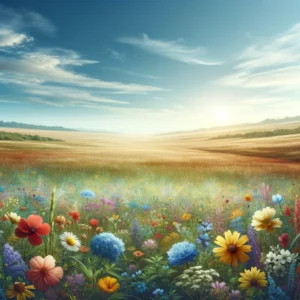“What does wildflower symbolize?”, Wildflowers, with their natural, untamed beauty and diverse appearances, offer a rich tapestry of symbolism and meaning across various cultures and contexts. Here is an expanded exploration of what wildflowers symbolize:

1. Freedom and Spontaneity
Wildflowers epitomize the essence of freedom and spontaneity. They grow without the need for human cultivation, flourishing in their natural habitat. This characteristic makes them symbols of a free spirit and an unstructured way of life. In literature and art, wildflowers often represent characters or settings that defy societal norms and conventions, embodying an untamed spirit that resonates with the desire for freedom in human nature.
2. Diversity and Resilience
The myriad of wildflowers, each differing in color, shape, and size, beautifully illustrates the concept of natural diversity. This diversity can be seen as a metaphor for the variety found in human societies, encouraging an appreciation for different cultures and perspectives. Moreover, the resilience of wildflowers, thriving in a range of environments, often in harsh or unexpected places, is a powerful symbol of endurance. They represent the ability to adapt and overcome adversity, a trait much admired and aspired to in human endeavors.
3. Joy and Happiness
The bright, colorful, and often delicate appearance of wildflowers is frequently associated with joy and happiness. They have a way of lightening the mood, bringing a sense of cheerfulness and positivity. This is why wildflowers are a popular choice for casual bouquets and decorations intended to uplift spirits and spread happiness.
4. Simplicity and Humility
In stark contrast to cultivated flowers, which are often bred for size and color, wildflowers stand out with their simple and unassuming beauty. This simplicity symbolizes modesty and humility, reminding us of the charm and elegance found in the simpler aspects of life. It underscores the importance of appreciating and finding joy in the small, everyday experiences.
5. Connection to Nature
Wildflowers serve as a poignant reminder of our deep connection to nature and the environment. They are a testament to the beauty of the earth’s natural cycles and the intricate ecosystems in which they exist. As symbols in environmental movements, wildflowers highlight the importance of preserving natural habitats and respecting the delicate balance of our planet. They encourage a sense of stewardship and responsibility towards the environment.
6. Hope and Renewal
The emergence of wildflowers, often in unexpected places and after harsh weather conditions, symbolizes hope and the potential for renewal. They remind us that life, even in the most difficult circumstances, can find a way to flourish and that there is always the potential for new beginnings. This symbolism is especially poignant in times of personal or collective challenges, offering a visual representation of optimism and resilience.
7. Love and Fidelity
In various cultural traditions, wildflowers hold special meaning in the realm of love and relationships. A bouquet of wildflowers, often picked directly from a field, can symbolize a pure, unpretentious form of love. They represent a deep, enduring affection that is not influenced by external factors. In folklore, wildflowers are often associated with fidelity and an unspoken understanding between lovers, signifying a connection that is natural and unforced.
8. Healing and Medicinal Properties
Many wildflowers are not just visually appealing but also possess medicinal properties. Throughout history, various cultures have used wildflowers for healing purposes. This aspect adds another layer of symbolism, representing healing, both physical and emotional, and the nurturing aspect of nature.
9. Symbolism in Different Cultures
The symbolism of wildflowers varies greatly across different cultures. In some traditions, specific wildflowers hold unique meanings, often tied to folklore and local customs. These meanings can range from good luck and prosperity to remembrance and mourning. The cultural significance of wildflowers adds depth to their symbolism, reflecting the diversity of human experience and belief systems.
Conclusion
Wildflowers, in their natural, unstructured form, carry a multitude of symbolic meanings. They inspire us with their freedom and spontaneity, remind us of the strength found in diversity and resilience, and bring joy with their simple beauty. As symbols of hope, renewal, and a deep connection to nature, wildflowers continue to play a significant role in our lives, whether in literature, art, or as part of our daily experience of the natural world. They are a testament to the enduring beauty and complexity of nature and its profound impact on human life and culture.
